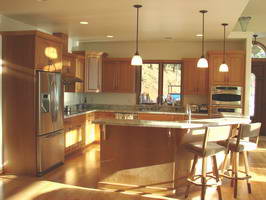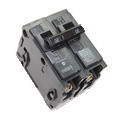How Bad Advice Can Burn Your House Down
 '; ';
|
How to Wire an Electric Kiln and How NOT to Wire an Electric Kiln. © By: Dave Rongey |
A Classic Example of Bad Advice
Question: I have a kiln with a 6-50plug. The kiln is: Operating Voltage: 240V (208V and 3 phase available)
Amperage: 40A Watts: 9600W
I read on a website that I could build an extension to connect it to my Dryer outlet which has a 10-30r. The Dryer breaker is 50A. I know that 50A to 30A extensions are available at RV and Welding resources, but are expensive and have slightly different plugs or receptacles than what I need, so I am making my own.
I have a 6-50r, connected to 25? of 10/3 wire(black, white and green) at one end and a 10-30p at the other. The black and white wires are attached to the side blades on both ends and the green to the center ones.
The Dryer wall outlet has black, red and white wiring. When I plugged it in(not yet attached to kiln) it not only tripped the Dryer breaker, but the main breaker also. I took apart both ends and saw that the white and black wires on the 10-30p were attached opposite from the Dryer outlet. I switched them and plugged it in again. It tripped the Dryer breaker but not the main. Again nothing is connected to the kiln. It blows the breaker as soon as plugged in to dryer outlet.
What am I doing wrong?
Also on the 6-50r the wires are held directly in place with 2 large copper screws and one silver one, with no plate in between the screws and wire.. Is this correct?
Thank you.
Bobby
This electrical question came from: Bobby, from Scottsdale, Arizona
Additional Comments: Thank you
Dave’s Reply:
Thanks for your electrical question Bobby
Incorrect and Hazardous Kiln Wiring
Understand Electrical Circuits and Prevent a House Fire
- A 30 amp dryer circuit can safely provide no more than 30 amps, and it can NOT safely provide 9600 watts to your kiln without damaging the electrical circuit.
- The 240 volt home dryer circuit should never have a circuit breaker installed that is larger than 30 amps otherwise the circuit could overheat to the point where there will be damage to the circuit wiring and components and could become a fire hazard.
- Because of what has been described I would highly recommend that the circuit be shut OFF and a Qualified Electrical Contractor be called to inspect the circuit for damage.
- Any wiring that has been done for the kiln should be checked as well and then compared to the nameplate or specifications of the kiln.
- If the 30 amp 240 volt dryer circuit has been used for the kiln then it may be damaged and need to be replaced as well.
- The adapter that you have described is incorrect and should not be used. The connections of the adapter are incorrect which is causing the circuit to trip OFF.
How to Wire an Electric Kiln
- From what has been described this 9600 watt 240 volt kiln will require a separate dedicated 50 amp 240 volt circuit.
RV 50 Amp Cord Adapters
The RV cord adapters that you have described are designed to safely provide 30 amps of power from a 50 amp circuit, NOT 50 amps of power from a 30 amp circuit – there is a BIG difference because the 30 amp circuit cannot provide 20 extra amps of power, and if it is attempted it will create a hazardous condition.
Home Electrical Circuit Breakers
A guide to home electrical circuit breakers and how they work to protect your electrical wiring. When properly installed, your home electrical wiring is protected by a circuit protection device.
Electrical Wire for the Home
Complete listing of electrical wire types and parts used for home projects with electrical code information serves as selection guidelines.
Wiring a Dryer for 3-Wire and 4-Wire Cords
3-Wire and 4-Wire Configurations for Clothes Dryers
See an electric dryer installation with a typical 220 Volt electric power cord wiring system. You may find yourself with either a 3-wire or 4-wire electric dryer, or a 3-wire or 4-wire outlet. Lets look a how the electric dryer is wired and what to do if your cord does not match the plug.
The following may also be helpful for you:
|
|
Be Careful and Be Safe - Never Work on Energized Circuits!
Consult your Local Building Department about Permits and Inspections for all Electric Wiring Projects.
More articles about Electrical Wiring and Home Electrical Wiring: |
|
| « Previous | Next » |
Electric Welder Circuit Sizes |
Generator ATS Provides Power During Partial Power Loss |

















